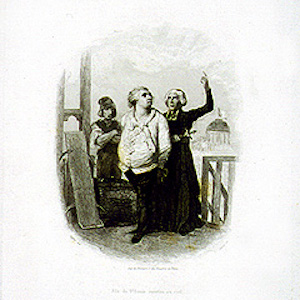Enlightenment

Louis XVI
Here was the "body politic" of the old regime. Theoretically, France existed only as an entity in the body of the King. The citizens were his subjects; the geographical parts linked together only through the monarch. Robed and wigged, he was an emblem of a centuries–old regime.

Execution of Louis XVI, January 21, 1793, 10:22 in the morning
This image shows much the same scene on the platform as the preceding one, but the surroundings are much more in evidence. Visible here are the troops. Eight to nine thousand were mobilized to avoid any efforts at rescue.

Son of Saint–Louis Going Up to Heaven . . .
Many scholars would argue that Louis XVI’s finest moment came from his bravery at his execution. Even when he was forbidden from saying a last few words to those gathered to see him executed, he remained unflinching, retaining his composure.

Louis XVI and His Family (20 January 1793)
Not shown in this or other scenes here is the fact that between the King’s two visits he ate a last meal. At this time he was denied, as was custom, a knife to avoid suicide. Louis was angered that his jailers thought he was so sinful as to take his own life.

Last Meeting of Louis XVI with His Family at the Temple Prison
Another version of the final meeting of the King with his family. To the left is his confessor; the figure to the right is most likely Cléry, the King’s valet.

Louis Leaves His Family
What links the many scenes we have of the King and his family is the modern sensibility on display in all of them. Of course, since dates are uncertain, we must assume that several images hail from the nineteenth century. Yet all confirm the sentimentality that the twentieth century so embraces.

Louis’s Separation from His Family
After hearing the verdict, the King was allowed a final evening with his family, whom he had not seen for almost a month during the trial. Twice on the evening of 20 January the King met with his wife, his son, and a daughter. For about an hour and three–quarters all told, they visited.

Image of the King on Trial
When he was charged, the King could have simply refused to participate on the grounds that the extant Constitution promised his immunity. But this defense, he knew, was useless and he elected to stand on his record.

Louis as Pig
The Queen, never popular to begin with in France, also bore the brunt of popular anger in 1792, as seen in these images of the King, the Queen, and elsewhere the entire royal family, as animals.

Marie Antoinette as a Serpent
The Queen, never popular to begin with in France, also bore the brunt of popular anger in 1792, as seen in these images of the King, Queen, and elsewhere the entire royal family, as animals.